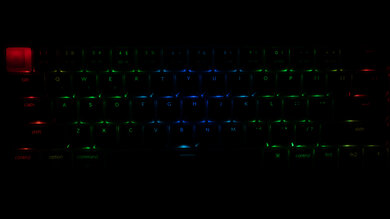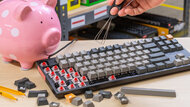The Keychron K14 is a wireless, compact 70% keyboard. It's advertised as a smaller alternative to a TenKeyLess model that retains a set of dedicated arrow keys and most navigational keys but lacks a function row. It connects wirelessly via Bluetooth, and you can pair it with up to three devices simultaneously. The unit we tested has Gateron G Pro Brown switches that feel fairly light to type on and offer good tactile feedback. There are several other variants available with different materials and backlighting options. They come in a range of Gateron G Pro or Keychron Mechanical switches, depending on their configuration, and there's also a hot-swappable version available. Unfortunately, while its latency is decent, it's high compared to most dedicated gaming options. Also, while it has two incline settings, it lacks an included wrist rest.
Our Verdict
The Keychron K14 is good for gaming, but it isn't designed for this use. It has full RGB backlighting with individually-lit keys, and its latency is decent, but it isn't as low as on most dedicated gaming keyboards. The ergonomics are also just okay, as it lacks a wrist rest. The unit we purchased has Gateron G Pro Brown switches which feel light and responsive, but they have fairly high pre-travel. That said, this keyboard is also available with other Gateron and Keychron Mechanical switches, depending on the version you purchase. There's also a hot-swappable version available, so you can install the switches you prefer.
-
Feels very well-built.
-
Full RGB backlighting with individually-lit keys.
-
Keys feel light and responsive.
-
Latency is too high for competitive or fast-paced gaming.
-
No companion software.
The Keychron K14 is decent for use with mobile devices. It connects via Bluetooth, and you can pair it with up to three devices simultaneously. It works without issues across Windows/Android and Mac/iOS, but certain function keys don't work in select operating systems. It also feels very well-made and has an aluminum frame. Unfortunately, it's heavy, and despite its relatively small overall footprint, it isn't ideal for carrying with you on the go.
-
Feels very well-built.
-
Supports multi-device pairing with up to three devices.
-
The keyboard feels heavy.
-
High-profile.
The Keychron K14 is good for office use. It has a fairly high profile and doesn't come with a wrist rest. That said, it feels very well-built and connects wirelessly via Bluetooth. Our unit has Gateron G Pro Brown switches which provide a light typing experience with good tactile feedback, and they're quiet enough for open office environments. You can get this keyboard in a variety of Gateron or Keychron Mechanical switches, and there's a hot-swappable version available, meaning you can install your own switches without soldering.
-
Feels very well-built.
-
Connects wirelessly via Bluetooth.
-
Great typing quality.
-
No wrist rest.
The Keychron K14 is good for programming. It has an aluminum frame and feels very well-built. It also has full RGB backlighting and works with any operating system. Unfortunately, the ergonomics are just okay, as it has a high profile and doesn't include a wrist rest. The unit we purchased has Gateron G Pro Brown switches which provide great typing quality, but it's also available in a range of other Gateron and Keychron Mechanical switches. There's also a hot-swappable version available, so you can use the switches you prefer. Unfortunately, there isn't any companion software, so you can't reprogram keys without relying on third-party software.
-
Feels very well-built.
-
Full RGB backlighting with individually-lit keys.
-
Connects wirelessly via Bluetooth.
-
Supports multi-device pairing with up to three devices.
-
No companion software.
-
No macro-programmable keys.
The Keychron K14 is adequate for use in a home theatre PC setup. It connects wirelessly with Bluetooth, and it has full RGB backlighting, so the keys are easy to see in a dark room. It also has a set of media hotkeys. Unfortunately, it doesn't have a trackpad, so you'll need a separate mouse to navigate on-screen menus.
-
Full RGB backlighting with individually-lit keys.
-
Connects wirelessly via Bluetooth.
-
Lacks a trackpad.
-
No volume wheel.
- 7.5 Gaming
- 7.4 Mobile/Tablet
- 7.6 Office
- 7.8 Programming
- 6.6 Entertainment / HTPC
Changelog
- Updated Sep 06, 2022: Added in a comparison to the recently reviewed Keychron V1.
- Updated Aug 18, 2022: Added a comparison to the newly reviewed Keychron Q7.
- Updated Jan 26, 2022: Review published.
- Updated Jan 20, 2022: Early access published.
- Updated Jan 10, 2022: Our testers have started testing this product.
Check Price
Differences Between Sizes And Variants
The Keychron K14 we tested has Gateron G Pro Brown switches, an aluminum frame, and full RGB backlighting, but there are several other configurations available, including versions with or without the aluminum frame, backlighting, and hot-swappable switches. The default switch types available for this keyboard include clicky, tactile, and linear versions of both Gateron G Pro switches or Keychron Mechanical switches, depending on what configuration you choose. All configurations are listed in the table below.
| Version | Color Scheme | Gateron G Pro Mechanical | Keychron Mechanical Switches | Hot-Swappable |
|---|---|---|---|---|
| Non-Backlit | Beige/Retro | None | Red, Blue, Brown | No |
| Non-Backlit Aluminum Frame | Beige/Retro | None | Red, Blue, Brown | Yes/No |
| White Backlit | Black/Gray | Red, Blue, Brown | None | Yes/No |
| RGB Backlit | Black/Gray | Red, Blue, Brown | None | Yes/No |
| RGB Backlit Aluminum | Black/Gray | Red, Blue, Brown | None | Yes/No |
The configuration we tested is indicated in bold within the table above. We expect our test results to be broadly applicable to all configurations; however, your typing experience will depend on the switch type you select. If you have a variant of the Keychron K14 that doesn't correspond to our review, let us know in the discussions, and we'll update it. You can see the label for our unit here.
Compared To Other Keyboards
As is typical for Keychron keyboards, the Keychron K14 is similar in many ways to other models within their lineup. Much of the difference between them comes down to their size. This keyboard is a rare, compact 70% form factor, which Keychron advertises as being a smaller alternative to a TKL. Unfortunately, like other Keychron models, there isn't any proprietary software, so while there's some limited customization possible for the RGB lighting directly on the board, you need to rely on third-party software if you want to rebind keys.
For other recommendations, check out our picks for the best keyboards for typing, the best wireless keyboards, and the best mechanical keyboards. For more models from Keychron, see our choices for the best Keychron keyboards.
The Keychron K12 and the Keychron K14 are very similar mechanical keyboards in different sizes. The K12 is a Compact (60%) keyboard available with various stock Gateron and Keychron switches. On the other hand, the Keychron K14 is a compact (70%) keyboard available in a range of Gateron G Pro or Keychron switches. Both keyboards also have hot-swappable versions available.
The Keychron K6 and Keychron K14 are similar wireless mechanical keyboards in different sizes. The K6 is a compact 60% available with Gateron or LK Optical switches and lower latency, while the Keychron K14 is a compact 70% model with four additional navigation keys. It's available with Gateron G Pro or Keychron Mechanical switches. The ABS keycaps on the Keychron K14 also have a nicer finish and feel better to type on. Additionally, there are hot-swappable versions available of both keyboards.
The Logitech MX Keys and the Keychron K14 are good wireless office keyboards. The Logitech is a low-profile, full-sized keyboard. It doesn't have any incline settings or an included wrist rest, but it has better ergonomics due to its low-profile, making it comfortable to type on for long periods. It has scissor switches with a tactile bump that requires a bit of force to get over, but they also feel very responsive thanks to a very low travel distance. It also has slightly lower latency, though neither board is very well-suited for gaming. On the other hand, the Keychron is a compact 70% keyboard available in a range of Gateron G Pro or Keychron Mechanical switches.
The Keychron K3 and the Keychron K14 are similar wireless mechanical keyboards. The K3 is a low-profile, compact 75% keyboard available in a range of Gateron low-profile or Keychron low-profile Optical switches. It also has a row of ten function keys which the K14 lacks. On the other hand, the K14 is available in a range of Gateron G Pro or Keychron Mechanical switches. The K14 offers a better typing experience because its keys don't wobble as much, and its ABS keycaps aren't as slippery. However, you may prefer the responsiveness of the low-profile keys on the K3 instead, especially for gaming. Both keyboards also have a hot-swappable version available, so you can install the switches you prefer without soldering.
The Keychron K2 (Version 2) and the Keychron K14 are very similar wireless mechanical keyboards, but they're different sizes. The Keychron K2 is a compact 75% keyboard available in Gateron Brown, Blue, or Red switches. It also has a row of 10 function keys which the Keychron K14 lacks. On the other hand, the Keychron K14 is a Compact 70% keyboard available in either Brown, Blue, or Red Gateron G Pro or Keychron Mechanical switches. The K14 also has a hot-swappable version available, while the K2 does not.
The Razer Huntsman is an outstanding full-sized, wired gaming keyboard, while the Keytchron K14 is a good compact 70% wireless office keyboard. The Razer comes with clicky Razer Optical switches and has hugely lower latency. It also has customization software, which the Keychron lacks. On the other hand, The Keychron feels somewhat sturdier and connects wirelessly via Bluetooth. It's available in a range of Gateron G Pro and Keychron Mechanical switches, and it has a hot-swappable version available.
The Keychron K14 and the Keychron Q7 are both compact (70%) keyboards manufactured by Keychron. The Q7 is a higher-end model with incredible build quality with an aluminum chassis and PBT keycaps, while the K14 is a more budget-friendly model with an all-plastic build. The Q7 also has companion software for further customization. Another major difference is that the Q7 is wired-only, while the K14 can connect with up to 3 devices using Bluetooth.
Video
Test Results
The Keychron K14 is a 70% compact keyboard with 72 keys. It's advertised as being smaller than a TKL keyboard and has dedicated arrow keys and some navigational keys. However, unlike the slightly larger 75% compact keyboards, which typically have 84 keys, this keyboard lacks a function row. Instead, the function keys on the Keychron K14 are combined as hotkeys on the number row.
The Keychron K14 feels very well-built. Its frame and baseplate are made of aluminum and have no noticeable flex. There's slight wobbling to the keys, but it's not noticeable while typing. The keycaps are doubleshot ABS, and they have a soft-touch coating that provides some grip. Overall, these keycaps feel much better than those on earlier Keychron models, which felt cheap and slippery. If you're interested in a similarly-sized keyboard with much better build quality, check out the Keychron Q7.
The Keychron K14 has okay ergonomics. It has two incline settings, but it has a fairly thick profile, and unfortunately, it doesn't include a wrist rest, so users may develop wrist fatigue after typing for long periods. That said, Keychron does offer wrist rests for sale on their website.
The Keychron K14 has excellent RGB backlighting with individually-lit keys. However, the color mixing is just okay, as the lighting has a noticeable blueish tint, and it doesn't get too bright. If you're looking for similar keyboards with customizable backlighting, check out the Keychron V Series.
The Keychron K14 comes with a braided USB-A to USB-C cable that's very similar to the cable on the Keychron K12. It feels good quality, but it's fairly stiff and retains kinks from its packaging.
The Keychron K14 has a 4000mAh rechargeable li-polymer battery that Keychron claims will last up to 240 hours with the backlighting off and 72 hours with full RGB lighting on. The user manual indicates the battery takes about three hours to charge. You can pair up to three devices using Bluetooth, and switching between them is easy.
Like other Keychron keyboards we've tested, the Keychron K14 has switches on the left side to alternate between Bluetooth/Wired Mode and Windows/Android and Mac/iOS, so you can use the mode that corresponds to your setup. You can control the backlighting using key combinations listed in the user manual. Additionally, you can disable the Auto Sleep Mode that turns off the backlighting after a default period of 10 minutes has passed in Bluetooth mode without any inputs. You can also add your own custom Auto Sleep Timer to adjust the amount of time before the lighting turns off if you prefer.
Our Keychron K14 has Gateron G Pro Brown switches which are very similar to regular Gateron Browns, but they're pre-lubed from the factory. They feel light to type on and have a slight tactile bump to overcome during actuation. They also have a fairly long pre-travel distance which can help prevent typos, but some users may prefer it were shorter for a snappier, more responsive feeling. The Keychron K14 is also available with Gateron G Pro clicky Blue or linear Red switches and proprietary Keychron Mechanical linear Brown, clicky Blue, or linear Reds, depending on the variant you purchase. The unit we tested isn't hot-swappable, but there's a hot-swappable version that allows you to install the switches you prefer without having to solder anything.
The typing experience on the Keychron K14 feels great with the Gateron G Pro Brown switches on our unit. The keys are quite stable, and the shape and spacing of the keys feel good for such a compact design. The keycaps themselves are made of doubleshot ABS plastic and have a soft-touch texture which makes them gripper-feeling than the keycaps on some of the earlier Keychron keyboards we've reviewed. Unfortunately, the keyboard has a tall profile, and it doesn't come with a wrist rest, so you may feel some strain or wrist fatigue after typing for a long time.
The Gateron G Pro Brown switches on our Keychron K14 are quiet to type on. However, the noise levels will differ if you choose a different switch type.
The latency on the Keychron K14 is decent, but it's likely too high for competitive or fast-paced gaming. That said, it's a fine choice for casual gaming and more than responsive enough for everyday browsing or office use.
The user manual suggests using Karabiner for Mac and SharpKeys for Windows to set macros. However, we don't consider this as official software as it isn't proprietary.
To properly use the Keychron K14 with certain operating systems, you need to use the switches on the left side of the board that corresponds to the computer or device you're using. The Keychron K14 is fully compatible with Windows, but the Screen Brightness button doesn't work on macOS. This may be because we test our keyboards on a Mac Mini without an official Mac screen. On Linux, the function keys only work as hotkeys, while for iOS devices, the F3 and F4 hotkeys don't work, and the Insert key does nothing. The F4 and Insert keys also don't work in iPad OS, and the F3 hotkey does nothing while the Option key brings up Google Assistant when using Android.
Comments
Keychron K14: Main Discussion
Let us know why you want us to review the product here, or encourage others to vote for this product.

































